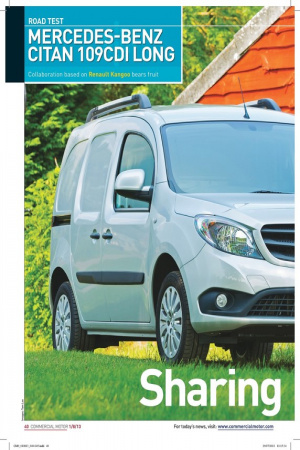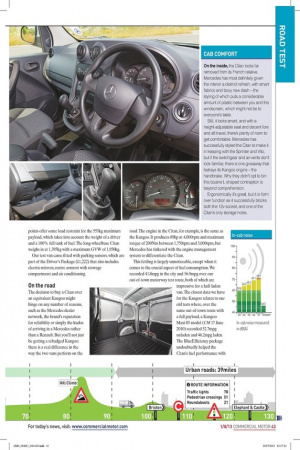The Citan, based on the Kangoo, is the result of
Page 33

Page 34

Page 35

Page 36

Page 37

If you've noticed an error in this article please click here to report it so we can fix it.
a collaboration between Mercedes-Benz and Renault. But is it fit for purpose?
It was early 2010 when news surfaced that Mercedes-Benz and Renault were to collaborate on a number of projects. The development of small cars and new engines was on the table, as was talk of Mercedes using the Kangoo platform to create its first small van.
The relationship made perfect business sense, extending Mercedes' range below the 2.8-tonne GVVV Vito, using shared technology and production facilities, but the decision to choose the Kangoo for some badgeengineering seemed unusual. In the medium and large van sector, Renault's Trafic and Master are seen as inferior products to the Vito and Sprinter, sowing a seed of doubt that Stuttgart was prepared to compromise quality to cash in on the small van segment.
Mercedes denies this, and in the Kangoo's defence, it is not a bad van: it's just not quite at the level you would expect from Mercedes. When the new Kangoobased Mercedes Citan was unveiled last year to more anticipation (and some trepidation) than usual, first impressions were encouraging. Mercedes had restyled the front end in accordance with the current trends in its passenger car range, and claimed to have not only tweaked the engine control unit, but also installed its own front suspension. These modifications are claimed to have improved fuel efficiency and sharpened the handling when compared with the Kangoo. They also differ on price, with the Citan understandably carrying a price premium to reflect its three-pointed star badge.
And where Renault streamlined its range in February 2012, deleting the Kangoo Compact from its line-up, Mercedes took the decision to offer a Compact version of the Citan in the UK. This provides 2.4m3 of loadspace and 330kg load capacity. Two other wheelbase lengths, long and extra-long, are also available, the latter offering a maximum load volume of 3.8m3 and 735kg payload capacity.
The Citan's 1.46-litre diesel engine is available in two ratings for the UK: the 108CDI engine produces 74hp; the 109CDI produces 89hp. On test here is the longwheelbase 109CDI BlueEfficiency. Productivity With a 2,697mm wheelbase, the long version of the Citan is a close competitor to the regular versions of Volkswagen's Caddy and Fiat's Doblo panel vans. It provides a respectable 3.1m3 of storage space in external dimensions of 4,321mm long, 1,829mm wide and 1,816mm high The loadspace is 1,753mm long, 1,460mm wide and 1258mm high. There is 1,219mm between the wheel arches, sufficient to accommodate a 1,000mm x 1,200mm pallet either way round.
A loading height of 575mm is among the highest in a city van, but we still found it low enough to lift heavy loads into the rear. Access to the loadspace can be sought through twin sliding side doors and 180 degree-opening asymmetric doors at the back. The handles on each of the doors feel a fraction flimsy as you pull, and while it wasn't apparent they would break, with frequent use we wouldn't be surprised to see a few missing in later life.
The rear sides of our van were protected by a halfheight plastic load lining, and there was also plastic covering for the floor. Six floor-mounted load lashing points offer some load restraint for the 555kg maximum payload, which takes into account the weight of a driver and a 100% full tank of fuel. The long-wheelbase Citan weighs in at 1,395kg with a maximum GVVV of 1,950kg.
Our test van came fitted with parking sensors, which are part of the Driver's Package (£1,222) that also includes electric mirrors, centre armrest with stowage compartment and air conditioning.
On the road The decision to buy a Citan over an equivalent Kangoo might hinge on any number of reasons, such as the Mercedes dealer network, the brand's reputation for reliability or simply the kudos of arriving in a Mercedes rather than a Renault. But you'll not just be getting a rebadged Kangoo: there is a real difference in the way the two vans perform on the road. The engine in the Citan, for example, is the same as the Kangoo. It produces 89hp at 4,000rpm and maximum torque of 200Nm between 1,750rpm and 3,000rpm, but Mercedes has tinkered with the engine management system to differentiate the Citan. the low rolling resistance tyres aiding motorway consumption and stop/start contributing to the best result we've seen so far over our city route. For the time being, it is advantage Mercedes, but Renault will undoubtedly return fire with the new Kangoo, due this summer, and we expect both to be on a par.
Our test vehicle came equipped with a five-speed gearbox that slides sweetly through the gate and is shared with the Kangoo. A sixth ratio might have seen economy improve further, but cruising at 70mph in fifth gear sees a moderately comfortable 2,679rpm engine speed, ensuring a motorway journey is possible in relative peace. A noise test of the Citan's cabin revealed little in the way of surprises, with the readouts matching the Kangoo at almost every speed. We did notice that the 195/65 R15 Michelin Energy Saver tyres produced a fair amount of noise over certain road surfaces.
Safety, security, equipment and value Mercedes prides itself on its safety innovations, and the Citan is full of the usual initials — Adaptive ESP, ABS, ASR (acceleration skid control) and BAS (brake assist). Disappointingly, though, the Citan's Euro NCAP score failed to live up to the mark, with a Kombi version receiving a three-star rating from the arbiters of European safety.
Nevertheless, it gets a driver's airbag as standard as well as a speed limiter and cruise control. Options fitted to our test vehicle include the aforementioned driver's package, and the appearance package (£686), which includes 15in alloy wheels, and body-coloured bumpers, mirrors and trim. An upgrade to larger 16in alloy wheels is available for £294.
On the whole, the Citan is well catered for. As with the Kangoo, which has long enjoyed a good range of add-ons, the Citan driver is not left wanting. Standard equipment includes a comprehensive trip computer, MP3 radio and Bluetooth connectivity. Importantly for a van that lacks any real storage solutions, the Citan also gets an overhead shelf — adding much-needed space to accompany the deep but narrow storage in the armrest and slender door pockets. •









































